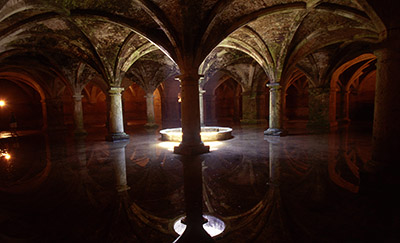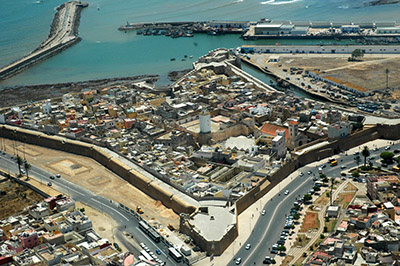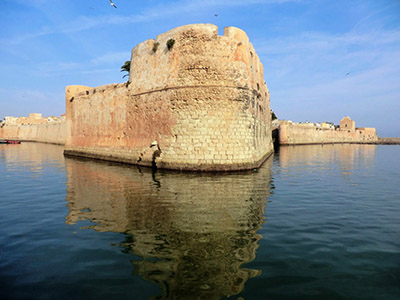 |
Fortress of Mazagan
Al-Jadida, Morocco
|
|
 |
Constructed: 1541 - 1542
Used by: Portugal, France, Morocco
Conflict in which it participated:
Shafirian Dynasty Anti-Portugalisms
|
El Jadida may have been one of several colonies established by the seafaring Carthaginians in the 5th century BC, and was referred to (in the name of Portus Rutilis) in Greek writings around 150BC.
The region in which Mazagan lies was technically owned by Portugal as early as 1486AD, but Portuguese explorers found the remains of a lookout tower at this site in 1502 and, as ever interested in pleasing ports, identified this location as an excellent candidate for fortification. The Portuguese got serious about establishing themselves there in 1514.
|
 |
|
|
Morocco and Portugal had been intertwined long before the mighty Portuguese Empire sailed the seas and built starforts everywhere. In the 12th century, much of Portugal and Spain were ruled by the Moroccan Berber Muslim Almohad Caliphate. It is no surprise that, following the Reconquista in which Portugal threw off its Moorish shackles in the 15th century, one of the first places that the Portuguese went in order to project power was the coast of Morocco. Well, that and the fact that it was very close to Portugal.
|
 Mazagan's famous cistern, the Cysterna Fortecy. A shallow layer of water (from which I would not drink) makes for pleasing reflections indeed. This cistern is a 111-foot-wide square, held together with five rows of stone pillars. Mazagan's famous cistern, the Cysterna Fortecy. A shallow layer of water (from which I would not drink) makes for pleasing reflections indeed. This cistern is a 111-foot-wide square, held together with five rows of stone pillars. |
 |
The Portuguese were firmly nestled into Mazagan when, in 1541, they were forced to abandon a number of important fortifications elsewhere in Morocco. Portugal's King John III (1502-1557) determined that Mazagan would be the focus of Portuguese power in the region, and sent João de Castilho (1470-1552), a renowned architect, to Morocco to fortify the town.
Interestingly, Castilho had built a series of impressive churches and cathedrals around Portugal, but as far as I can tell was not known as a military engineer. Dude must have known what he was doing, however, as here it is coming up on five centuries later and the vast majority of this starfort of our current interest is still standing. |
|
The Fortress of Mazagan was constructed around a cistern (an underground, waterproof receptacle used for the collection and storage of rainwater) that had been built in 1514, as without a supply of drinking water, no garrison would last long under siege no matter how pointy were their starfort bastions. The fortress was built in a single year, its 25-foot-high walls averaging about 30 feet in thickness, supporting a 6-foot-wide walkway along the top of each wall.
The Fortress of Mazagan originally had five bastions: St. Sebastian Bastion in the north; Holy Ghost Bastion in the south; Angel Bastion in the east; St. Antoine Bastion in the west; and the Governor's Bastion at the fort's main gate along the western wall. There were three gates, including a sea gate, which afforded direct access to the ocean at high tide. A 60-foot-wide, 9-foot-deep ditch filled with seawater surrounded the fort.
|
All of these attributes proved useful when the Sultan Abdallah al-Ghalib (1517-1574) sent his son Muley to lead a force of 150,000 men to Mazagan in February of 1562 to take the fortress from the wicked Portuguese. The fort's garrison numbered 2600, of whom 260 were left alive when the Moors gave up and raised the siege on May 7, 1562. All told, over 25,000 men were killed in the battles that were part of this failed siege.
All of this bloodshed bought Portugal another 200 years of colonial supremacy along the coast of Morocco, but the efforts of Sultan Mohammed ben Abdallah (1710-1790) finally forced the Portuguese to abandon the Fortress of Mazagan in 1769.
|
 |
 The Fortress of Mazagan from the west, the St. Antoine Bastion leading the way. The Fortress of Mazagan from the west, the St. Antoine Bastion leading the way. |
|
Mazagan had in fact been the final bastion of Portugalism in Morocco. The last remnants of the Portuguese Empire in North Africa departed through the Fortress of Mazagan's sea port on May 10, 1769...and sailed straight to Brazil, where they established the town of New Mazagan (now known simply as Mazagão), just a bit down the Amazon River from the spectacularly starry Fortaleza de São José de Macapá at the Portuguese colonial city of Macapá.
|
 Angel Bastion, the fortress' southernmost defensive edifice. Good thing nobody blew this one up, because it's awfully nice to look at. Angel Bastion, the fortress' southernmost defensive edifice. Good thing nobody blew this one up, because it's awfully nice to look at. |
 |
As a final farewell thumb-to-the-nose that may or may not have been absolutely necessary, the Fortress of Mazagan's departing garrison undermined the fort's Governor's Bastion, blowing it up and rendering it problematic for anyone wishing to use it as the fort's main entrance in the future. This is why the Fortress of Mazagan one sees at the top of this page has four bastions, as opposed to its original five.
Ultimately the fortress was of no particular interest to Sultan Abdallah al-Ghalib (or his son Muley), once it was no longer filled with Portuguese soldiers. The city of Mazagan (assumedly destroyed by the fight to evict the Portuguese) was renamed al-Mahdouma (the Ruined), abandoned and left to the elements.
|
|
Sultan Abd al-Rahman (1778-1859) ordered the rebuilding of the town in 1824, which was when al-Jadida got its current name, which translates as the New.Though the Portuguese had been vanquished in North Africa, through much of the 19th century Morocco fought a losing battle against the colonial ambitions of both France and Spain. To this day there remains the weird little entity that is Ceuta, a spit of land that is clearly, physically attached to Morocco, yet claimed by Spain...upon which the Fortaleza de Hacho continues to house elements of the Spanish military, despite Morocco's earnest wish that they would please go away. Signed in 1912, the Treaty of Fez established Morocco as a French protectorate. This meant that Morocco would be part of, though autonomous from, France, though not really. Whatever form this "autonomy" actually took, it was all part of the frantic spasm of colonialism that took place in the years leading up to the First World War (1914-1918).
|
Imagining that their nice new port might one day need to be defended, the French made an effort to mend the crumbling Fortress of Mazagan. Its walls strengthened, most of its ditch filled in and all hints that there had once been a Governor's Bastion eradicated, by the start of the First World War the fortress was, if not a state-of-the-art 20th century artillery fort, at least somewhat ready to defend itself. From 18th century sailing ships.
Fortunately no such ships ever materialized, and the French protectorate ended, semi-peacefully, in 1956.
|
 |
|
|
The Fortress of Mazagan's breathtaking cistern has been featured in a number of movies, including Orson Welles (1915-1985)' 1952 adaption of Othello.In 2009 the Fortress of Mazagan was voted one of the Seven Wonders of Portuguese Origin In the World, as catchy a category name as I've ever heard. Among the other elected wonders were such bulwarks of Portuguese power as Fort Jesus in Mombasa, Kenya and the Fort of Our Lady of the Conception in the Strait of Hormuz.
|
|
|
|
|
|
 |




